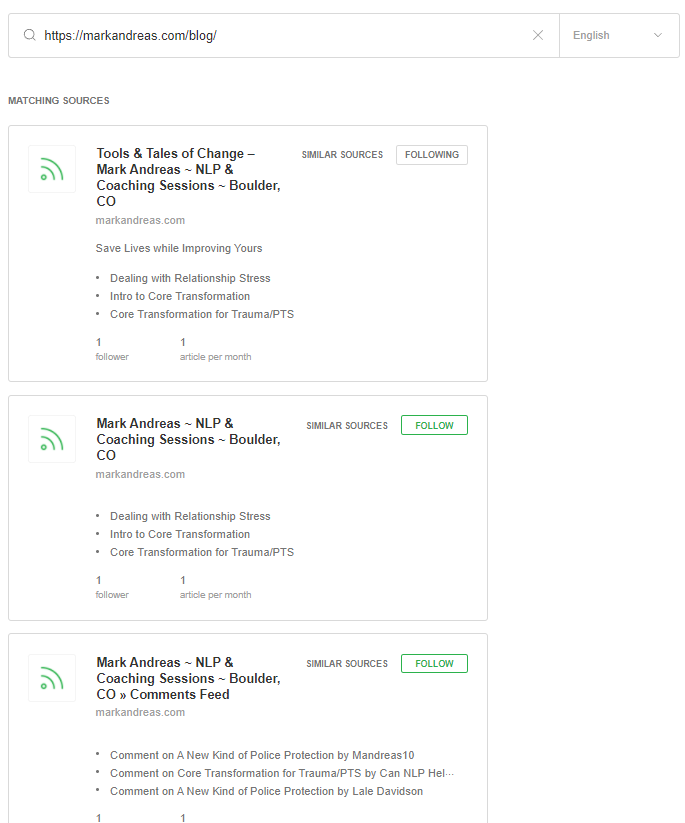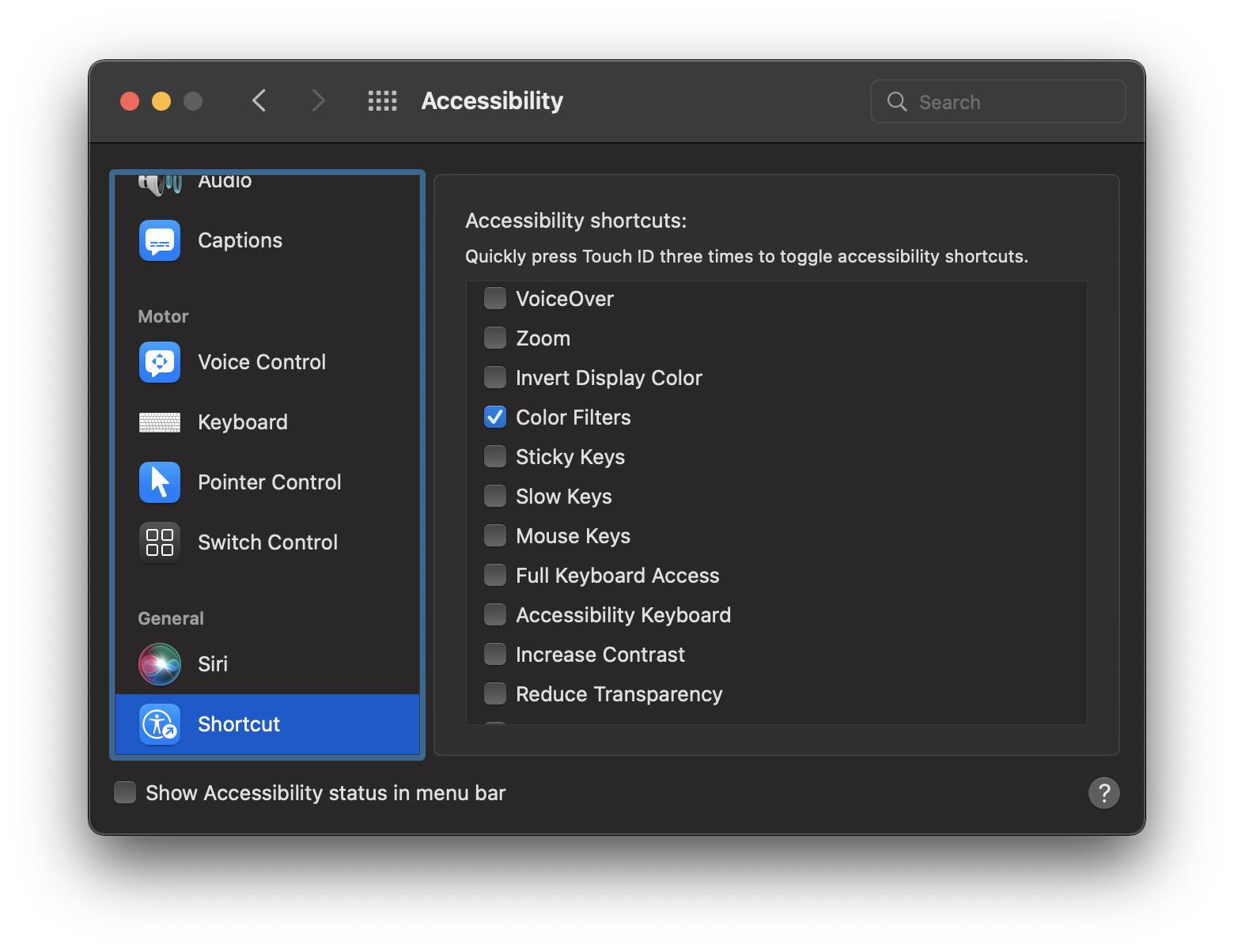It’s baffling and tragic that RSS is being treated like a dead protocol by much of the tech world. How did we get here?
Also, thanks for the tip! (Grayscale)
Windows 10
Settings -> Personalization -> Background (should be where you landed on Personalization) -> Color Filters -> Use color filter: On (Optional: check box to select shortcut key) -> grayscale (or other)
Windows 11
Settings -> Accessibility -> Color filters -> Color filters: On -> Grayscale (Optional: check box to select shortcut key)
I'm curious about your reasons for making your monitors greyscale. What are the benefits of that for you?
Interesting effect - prompted by this post, l turned my phone grayscale for a while and didn't really notice much of a difference, but then I turned colors back on today because the mobile ticket for the local bus is something you need to show to the driver and it's color-coded. And suddenly I'm appreciating the colors on the phone a lot more, they're nice and aesthetic.
I don't think this will actually make me more addicted to my phone but I do feel happier to have had things on grayscale for a while, since now I get extra happiness from using my phone (until I get used to it again which will likely happen soon - maybe I'll then go back to grayscale again so I can get used to that and then switch back again :D).
Interesting. When I have to turn colors back on (e.g. to look at a graph) it feels like I'm being assaulted with candy. Humans are so fucking varied.
Reporting back two weeks later: my phone usage is down about 25%, but that's within my usual variance. If there's an effect, it's small enough to not be immediately obvious, and would need some more data to get anything resembling a low p-value.
Anecdotally, though, I'm quite liking having my phone on "almost-greyscale" (chromatic reading mode on my OnePlus phone). When I have to turn it off, the colours feel overwhelming. It also feels like it encourages me to focus on the real world, rather than staring at my phone in a public place.
I just made my entire digital life grayscale and I like it a lot. I’ve even figured out how to make retro monitor colors like amber and green. Its only been a few hours, but notice that I appreciate real life colors more and YouTube is less addictive. I also feel for colorblind people now, because I’ve noticed people in articles or videos talk about “the blue line in this chart” or whatever and I have to guess which one they mean.
Color is used by designers to get your attention. Red, especially, being the color of blood, draws your eye. Color can be especially distracting for those with ADHD.
Interesting. Complete greyscale sounds like a lot of hassle, but I'm going to try turning the contrast on my phone down to nearly zero and see if I notice any difference.
where Feedly requires you to not only go to its own page to add feeds, but track down the actual feed URL rather than figuring it out from the blog’s homepage URL
I'm confused now, because I've definitely just given Feedly a blog's URL and had it figure out the feed from that. Just tested it by giving it an URL now, and it returned three different feeds, two of them being for the blog itself and one being the comments for the blog.

shrug I definitely ran into this repeatedly without an intervening success, it's possible there was something weird because they were older websites.
When I ran into something similar, my theory was that Feedly used what everyone else had saved to identify the RSS or atom feeds. Based on it being more obscure things that would fail for me.
I've been using Inoreader for a good while and can vouch for it as a very solid choice of RSS aggregator. I've tried others and still like Ino the best.
Especially useful when a site doesn't provide a feed, as it has some tools to monitor a page for updates/changes and present that as a feed for you.
On macOS, you can quickly toggle grayscale on and off by pushing (not tapping) the Touch ID button three times. You'll want to disable everything except "Color Filters" before doing this:

You can also set up a shortcut for toggling grayscale on Android (simultaneously pressing the top and bottom of the volume button is the trigger). Instructions here. (Annoyingly, this also sometimes forces a reload of whatever you're looking at, so you can lose data if you've e.g. started filling out a form and then toggle grayscale.)
My Android Motorola phone nudged me into using setting a nighttime grayscale mode. I love it. It stops me from scrolling Twitter (I'm not a power user) late at night when my mind is too dead to do anything else, and I should go to bed.
I am hyper-aesthetically conscious so the change is very affecting for me. It greatly reduces my desire to head towards snappy things.
Strong +1 to Focus Mode; I'm not doing the rest of this but I do find it extremely valuable to be able to temporarily turn off things that are going to pull my attention in twenty different directions unexpectedly. I use it when I'm working and also sometimes when I go on walks where I want to be able to use my phone to take pictures and check maps but not to be distracted by the Internet.
(note: not available for Android, so I have to manually copy the URL and open the Pocket app).
Can you not simply share the URL to the pocket app? Instead of actually opening the app? This works for me quite nicely
On the topic of grayscale: Love it, strongly recommend trying to everyone too.
What I'd really like to see is a way to selectively grayscale applications, or exclude some from the grayscale filter. (So e.g. if I'm running Gimp/PS/..., keep just that one non-grayscale while still desaturating everything else.) If anyone knows anything, all pointers are strongly appreciated!
(I think it ought to be possible with the X server permissions model on Linux, but I'm not sure if a program could even have the permissions to do this on Windows.)
As part of my ongoing effort to improve my cost/benefit ratio on social media, I’m nudging myself away from intellectual mosh pit platforms like Facebook and Twitter, and towards blog posts, articles, videos essays, etc. Really longform consumption (e.g. books) remains about the same, my limitations on that are mostly my insistence on fact-checking nonfiction and very narrow tastes in fiction, this post is about changing what I reach for when I’m bored in a line. Towards that goal I have made a few changes, which I list here roughly in ascending order of how much effort they were:
How to Combine All Article-Length Content
The following instructions work with both Inoreader and Feedly. I eventually chose Inoreader but it was a close call and your mileage may vary.
Tada! With a mere 20 minutes of work and a small monthly fee you have a system that combines all of your article-length-content in one place. Inoreader and Feedly both support Youtube channels and podcasts as well, although I haven’t tested those out.
Rejected Options
Pocket
Pocket bafflingly doesn’t support RSS input. You can hack it with IFTTT or Zapier, but each RSS feed counts as its own applet so you reach the $10/month plan very quickly. This is slightly cheaper than the Feedly pro plan but more than Inoreader, plus paying Inoreader gets rid of ads.
Pocket allows you to forward individual emails to it, but because Gmail requires forwarding address confirmation you can’t automate forwarding to pocket from Gmail. You could fix this with a newsletter-to-RSS converter and then IFTTT/Zapier, but that’s a lot of work.
Feedly
I originally settled on Feedly before making one final sweep and choosing Inoreader instead. The driving concern was that Feedly required me to be on tier 3 ($12) rather than Inoreader’s tier 2 ($6). Inoreader’s browser plugin was also better, letting you subscribe while on a blog’s homepage, where Feedly requires you to not only go to its own page to add feeds, but track down the actual feed URL rather than figuring it out from the blog’s homepage URL (which is surprisingly hard because RSS is out of favor and most readers can guess, so the RSS feed is rarely displayed prominently).
I do like the Feedly Android app a little more; Inoreader has not adjusted to Pixel’s lack of a back button and eats the replacement gesture, but I liked the webapp more so stuck with Inoreader.
Feedly Pro+ (required to get newsletter forwarding) boasts an AI assistant I assume is terrible. Inoreader has easily accessible filters and prioritization rules that I haven’t tested. Between the two of these I predict I get more value out of Inoreader, but I could be wrong.
Lastly, Feedly promised me a trial and immediately charged me for an annual subscription, so they can die in a fire.
Everyone Else
This is a spreadsheet where I went through every read-it-later service I could find, looking for RSS native support. None of them had it. It is possible there is another RSS reader with better bookmarking or newsletter support, but I am exhausted and Inoreader is working so I stopped looking.